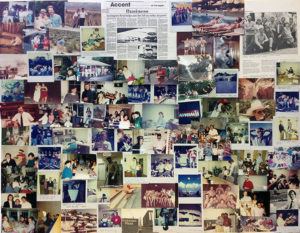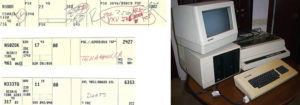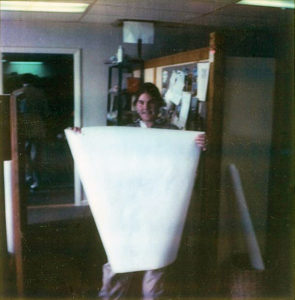Throwback Thursday (TBT): My First Noise Contours
03.20.2014 | HMMH |At the risk of mixing social media platforms (and incurring an eye roll from my teenage daughter), I’d like to announce a new blog series at HMMH: Throwback Thursdays.
This idea was sparked as a result of the recent renovation of our Burlington headquarters, and the desire to preserve this collage that was prepared for the occasion of HMMH’s 10th Anniversary in 1991:
Our team has invested significant time scanning each of the photos in the collage, and my hope is that we can find something interesting to say about most of them (well, there are some NSFW things that won’t be shared).
My First Noise Contours
I thought I’d start off with a photo of my first noise contours. As the date indicates, it was November 1984 (yes, I am that old); I was fresh from Cornell and a summer Internship with the Massport Planning Department; still wearing Birkenstocks and going to Grateful Dead shows (yes, I am that old). Back in the day, this is what noise contour development looked like:
- Operational Inputs were developed by typing ATC flight progress strips (see below) into a Lotus 1-2-3 spreadsheet on the company’s only computer – a Xerox (which looked something like this):
- Flight tracks were developed in one of two ways: (a) interviewing the Control Tower manager, who would describe nominal controller instructions to pilots (e.g., Climb to 1000’, then turn on course”), or (2) someone (guess who?) would sit in front of a radar scope marking radar return dots on a piece of acetate – literally, dot-to-dot flight tracks. These days, I just smile at folks who get worked up for only getting a 99% radar track sample to analyze.
- Then the real fun began! We typed the INM “input deck” (I’m a version 2.7 girl – we old-timers mark our age by first model used) into the computer (my colleagues will tell you about their experiences with punch cards, and submitted it to Control Data Corporation (CDC) over a dial-up modem for processing. Each run cost several hundred dollars – we did a lot of QC before submitting! Assuming all went well, we then got to DRIVE to Waltham (20 minutes without traffic) to talk to Manny and get the output – a green and white computer printout and (hopefully) a large plot with contours!
Next up: Zipatone and Field trips of the 1980s!









